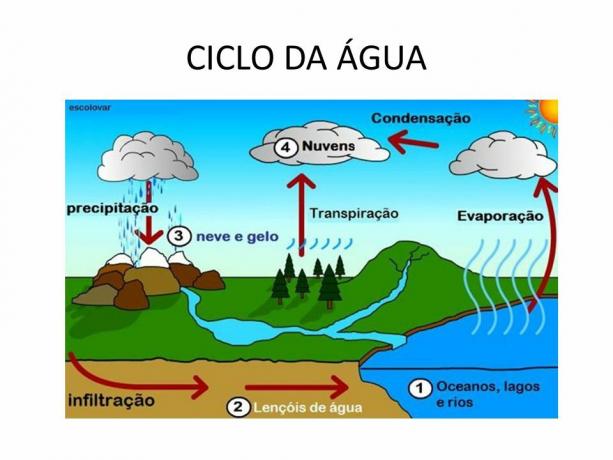As the cliché says, water is life. Water is a natural element that is used by all living and non-living things. Water is in a perpetual state of movement and transition from one state to another. There are three states of water: solid, liquid and steam.
The water cycle, also known as hydrological cycle, refers to the endless movement of water on the Earth's surfaces. The total mass of water present on Earth is relatively constant over time.
Whether this water is present as salt, fresh or in the atmosphere will depend on a wide range of climatic variables. Whatever these variables are, the mass remains constant. For example, for the amount of water in the atmosphere to increase, it means that the amount of salt water or fresh water has decreased.
Basic science shows that matter cannot be created or destroyed, but it can be changed. There are several processes by which water moves from one state to another, including evaporation, infiltration, surface and underground flow, as well as condensation and precipitation.

Water can change states (ice, liquid or vapor) through the evaporation, condensation and precipitation. Surface or subsurface flow only serves to move water from one location to another.
Approximately 96% of the total amount of water on earth it is made up of salt water. Only 4% corresponds to fresh water. Approximately 68% of fresh water is in glaciers and another 30% is found underground.
Index
- Water Cycle Steps
- Other processes in the water cycle
- Effects on Climate
Water Cycle Steps
- Free Online Inclusive Education Course
- Free Online Toy Library and Learning Course
- Free Online Math Games Course in Early Childhood Education
- Free Online Pedagogical Cultural Workshops Course
- The sun is the main source of energy for the cycle. When the sun rises, it heats the water that is out in the open. The larger the body of water, the greater the effect. The water particles absorb energy from the sun and, in turn, evaporate in the atmosphere. For water to evaporate, it does not need to be in liquid form as ice and snow can also be evaporated.
- Snow and ice can first go into a liquid state and then evaporate, or the temperature can be high enough to sublimate the substance. Sublimation is a process in which a substance changes from a solid to a gas directly, without turning into a liquid first.
- When the temperature drops sufficiently, water vapor, filled with energy from the sun, begins to transfer this heat to the surrounding atmosphere. When water vapor transfers enough energy, precipitation (tiny droplets of water) forms in a process called condensation.
- A massive concentration of precipitation is visible from the earth's surface as clouds. The higher the level, the darker the clouds. Sometimes fog or mist can form when condensation occurs near the surface. Condensation near the ground can be due to a sudden drop in air pressure or when a hot, humid wind collides with a cold wind.
- Clouds filled with precipitation can cause rain in the region they formed, or they can be blown away by the wind to deposit their load in other areas of the world. Precipitation can fall in different ways depending on the temperature in the clouds.
- When the temperature is above 2 degrees, the precipitation is likely to be in liquid form, also known as rain. On the other hand, when the temperature is below 2⁰, then it forms crystal particles that will fall like hail or snow.
Other processes in the water cycle
There are two main processes involved. The first is precipitation. Precipitation refers to water vapor condensed high in the atmosphere that falls on the Earth's surface. Most of the precipitation falls as rain and approximately 78% of global precipitation falls on the ocean, with most of the remaining percentage falling to the land, while a small portion forms snow. Some of the water vapor can change directly to ice in a process known as deposition.
The second process is evaporation. Evaporation is the process by which water changes from a liquid to a gaseous state and rises to the atmosphere. When evaporation is mentioned, it also includes transpiration from vegetation. Collectively, vapor from plants and water bodies is known as evapotranspiration.
Not surprisingly, most of the gas comes from oceans and large bodies of water, as they are more exposed to the effects of the sun. Evaporation from the oceans represents 86% of global water vapor.
There are several smaller processes like infiltration. Infiltration refers to the myriad ways that water passes through the land. As water flows, some of it drains into large bodies of water, while some seeps into the land.
Infiltration also leads to a process known as sub-surface flow. As the name suggests, flow below the surface is the movement of water below the surface of the earth. Part of this water is deposited in aquifers, drains into the oceans or returns to the surface as springs.
Effects on Climate
In addition to influencing the climate, the water cycle is also responsible for purifying water when it evaporates. When dirty liquid water evaporates, only the water particles turn to steam. The impurities that are in the water are left on the surface.
When this vapor falls in the form of rain, the water becomes viable for human consumption. The flow of water on and below the earth's surface also plays a crucial role in moving minerals from one region to another.
The password has been sent to your email.

